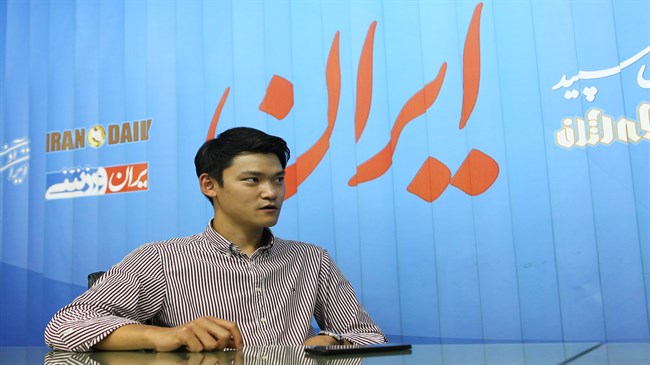
Excerpts from the interview follow:
What is your opinion about Iran and its people?
KO YOHAN: Actually, I had heard a lot of bad news about Iran. I was worried about coming to Iran. But during my participation in different programs, I met a lot of artists here in Iran. They were really kind and hospitable to me. I was really impressed. What I had heard about Iran was not true.
Because your father had previously visited Iran, did you ask him about his experiences in Iran?
Yes, I have asked, he told me that Iranians are very kind. And I told my family members that they should not worry about me; Iran is so impressive that I don’t want to come back to Korea.
What was the most interesting part of your experiences in Iran?
Everything was O.K. During my stay in Iran, I visited several museums which are unique compared to Korea. I was really surprised about the number of museums and their qualities in Iran. I also met a lot of Iranian artists and it was really important to me. In addition, Iran’s culture and environment are very different from Korea.
Has the quality of art in Iran changed your definition of art?
Yes, it has. I received a lot of new ideas during this residency program. But the time was not enough for me, and I could not visit several cities. In the future, if I have more chances to stay in Iran, I would like to visit new places.
Would you please talk a little bit about Korean contemporary art?
Actually, it is a difficult question for me to answer. Art in Korea is intermingled with financial issues. Like other countries, Korean art is entangled with the problem of money. Selling artwork is a big problem which preoccupies Korean artists as well as artists in other countries.
I don’t have precise information about Korean art, but about my experiences in China, I can say that I love classic Chinese art more than Korean, but in terms of modern art, I prefer Korean art.
What is the reason behind that?
I think it depends on cultural issues. Traditional Chinese art is of high quality, but their modern artworks have been a little bit influenced by socialism as well as ideological and political thoughts.
Which traditional Korean art do you love more: Painting, handicrafts, or sculpture?
Definitely painting. Koreans prefer to paint with paper and brush. But I know that in China, Korea and Japan, traditional artists go to nature and stay there and once they are back to the studio, they paint their understanding of nature.
What is your idea about natural art in Korea?
YATOO is Korean Nature Artists’ Association. It began its activities 37 years ago with only 10 individuals and without any governmental support and their office is a tent. Finding sponsorship for natural art is very difficult in Korea.
What is the difference between nature art in Korea and other countries?
Perhaps the most important characteristic is that Koreans do not carry anything extra with themselves to nature, and they use natural materials. My father told me that in my visit to Iran I would learn a lot from Iranian nature art, because they have excellent ideas about nature art.
9060**1396
Follow us on Twitter @IrnaEnglish
 solhkhabar | Peace International News Agency Peace International News Agency , Peace News , International Agency News of Peace
solhkhabar | Peace International News Agency Peace International News Agency , Peace News , International Agency News of Peace